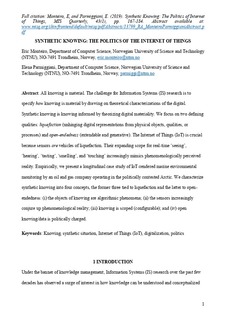| dc.contributor.author | Monteiro, Eric | |
| dc.contributor.author | Parmiggiani, Elena | |
| dc.date.accessioned | 2019-04-25T14:30:34Z | |
| dc.date.available | 2019-04-25T14:30:34Z | |
| dc.date.created | 2018-11-05T11:20:36Z | |
| dc.date.issued | 2019 | |
| dc.identifier.citation | MIS Quarterly. 2019, 43 (1), 167-184. | nb_NO |
| dc.identifier.issn | 0276-7783 | |
| dc.identifier.uri | http://hdl.handle.net/11250/2595559 | |
| dc.description.abstract | All knowing is material. The challenge for Information Systems research is to specify how knowing is material by drawing on theoretical characterizations of the digital. Synthetic knowing is knowing informed by theorizing digital materiality. We focus on two defining qualities: liquefaction (unhinging digital representations from physical objects, qualities, or processes) and open-endedness (extendable and generative). The Internet of Things (IoT) is crucial because sensors are vehicles of liquefaction. Their expanding scope for real-time “seeing,” “hearing,” “tasting,” “smelling,” and “touching” increasingly mimics phenomenologically perceived reality. Empirically, we present a longitudinal case study of IoT-rendered marine environmental monitoring by an oil and gas company operating in the politically contested Arctic. We characterize synthetic knowing into four concepts, the first three tied to liquefaction and the last to open-endedness: (1) the objects of knowing are algorithmic phenomena; (2) the sensors increasingly conjure up phenomenological reality; (3) knowing is scoped (configurable); and (4) open knowing/data is politically charged. | nb_NO |
| dc.language.iso | eng | nb_NO |
| dc.publisher | University of Minnesota, Management Information Systems Research Center | nb_NO |
| dc.title | Synthetic Knowing: The Politics of the Internet of Things | nb_NO |
| dc.type | Journal article | nb_NO |
| dc.type | Peer reviewed | nb_NO |
| dc.description.version | acceptedVersion | nb_NO |
| dc.source.pagenumber | 167-184 | nb_NO |
| dc.source.volume | 43 | nb_NO |
| dc.source.journal | MIS Quarterly | nb_NO |
| dc.source.issue | 1 | nb_NO |
| dc.identifier.doi | 10.25300/MISQ/2019/13799 | |
| dc.identifier.cristin | 1627007 | |
| dc.relation.project | Norges forskningsråd: 237898 | nb_NO |
| dc.relation.project | Norges forskningsråd: 213115 | nb_NO |
| dc.relation.project | Norges forskningsråd: 40122563 | nb_NO |
| dc.description.localcode | © 2018. This is the authors’ accepted and refereed manuscript to the article. Locked until 27.10.2023 due to copyright restrictions. | nb_NO |
| cristin.unitcode | 194,63,10,0 | |
| cristin.unitname | Institutt for datateknologi og informatikk | |
| cristin.ispublished | true | |
| cristin.fulltext | postprint | |
| cristin.qualitycode | 2 | |
